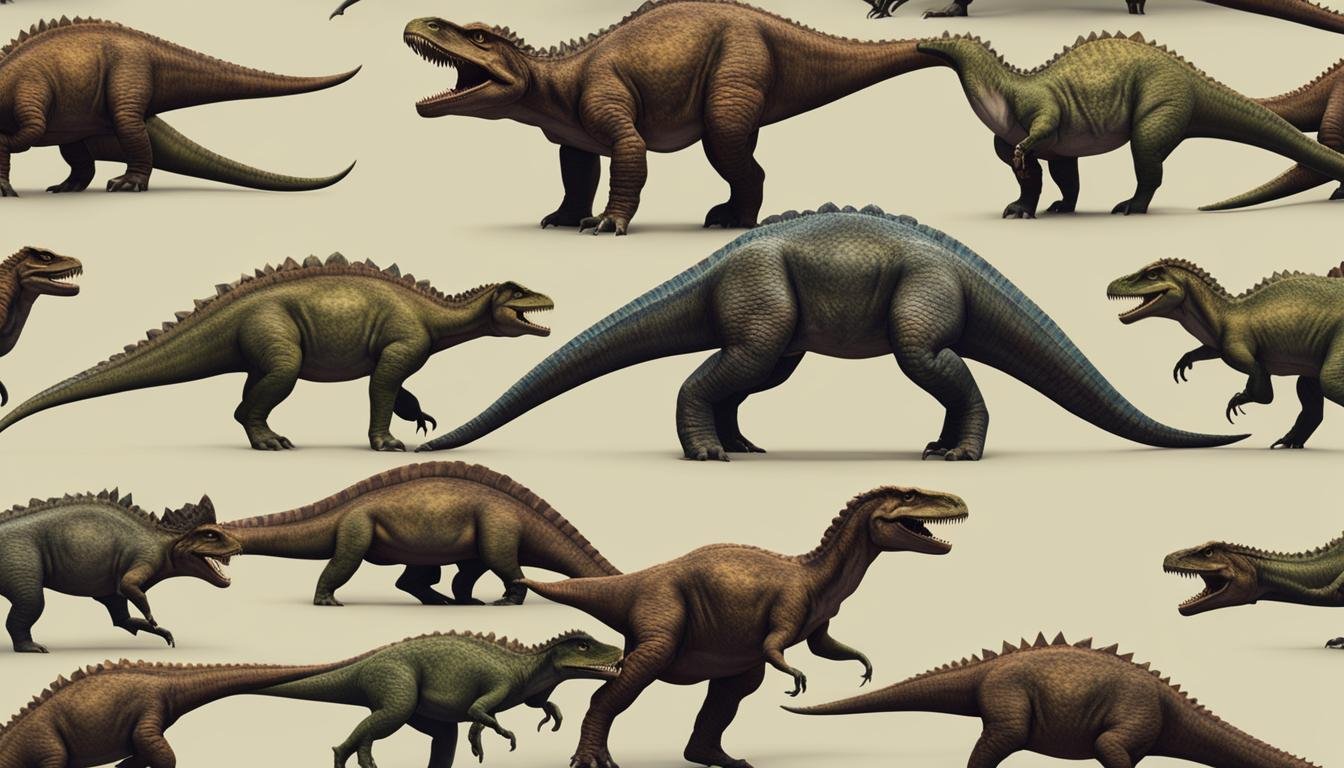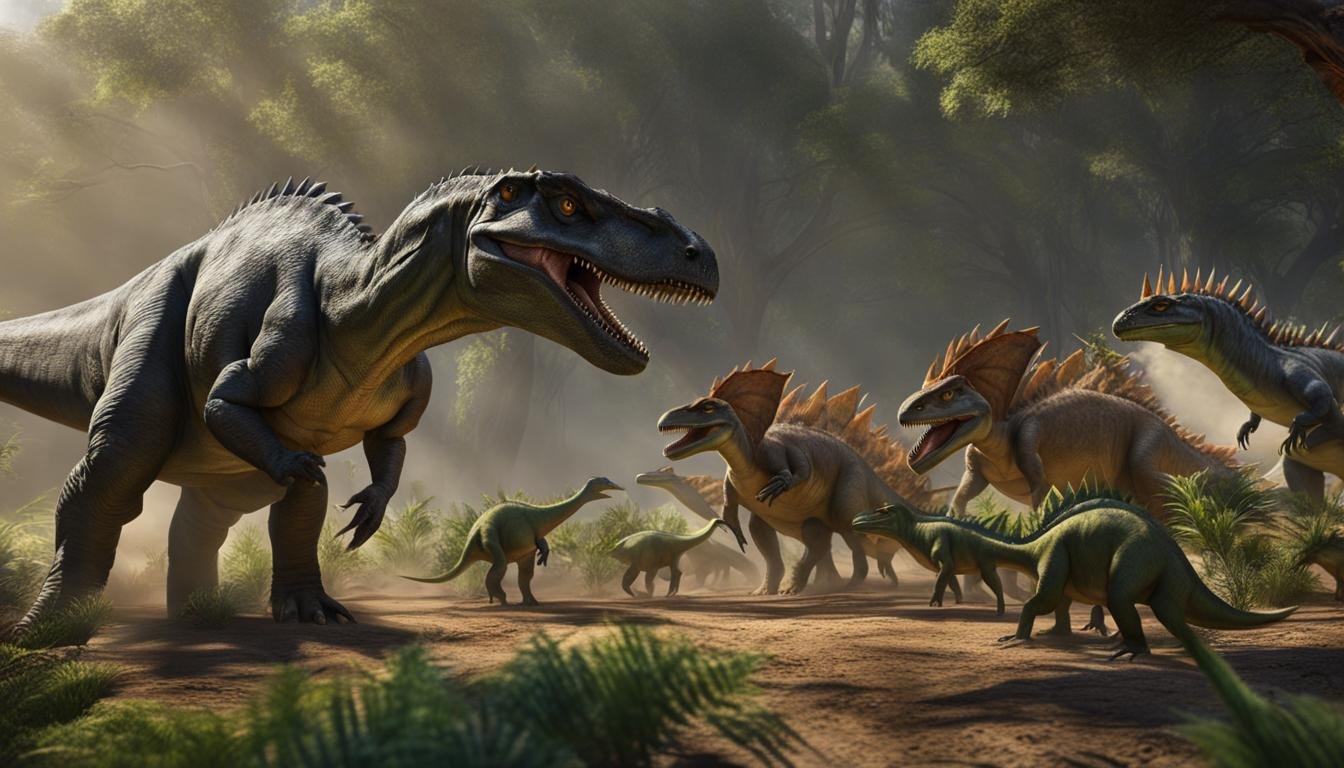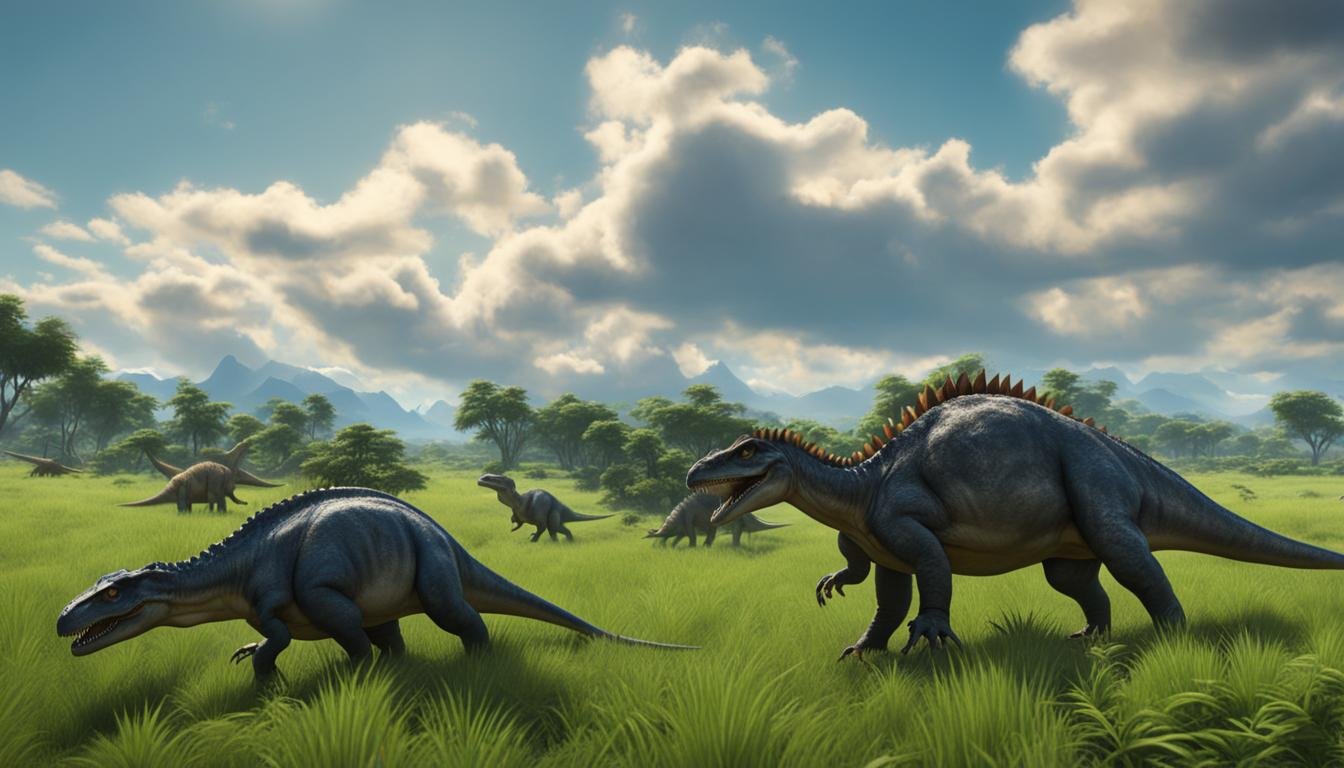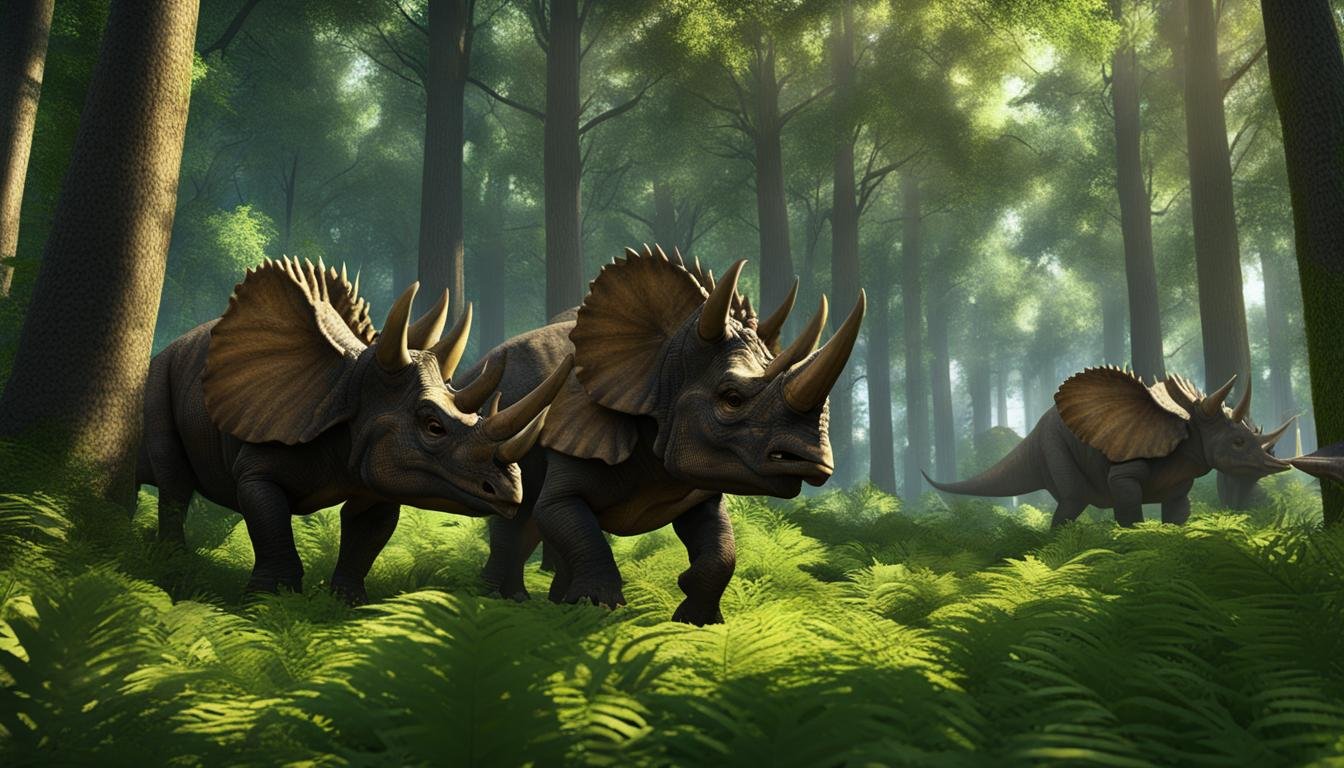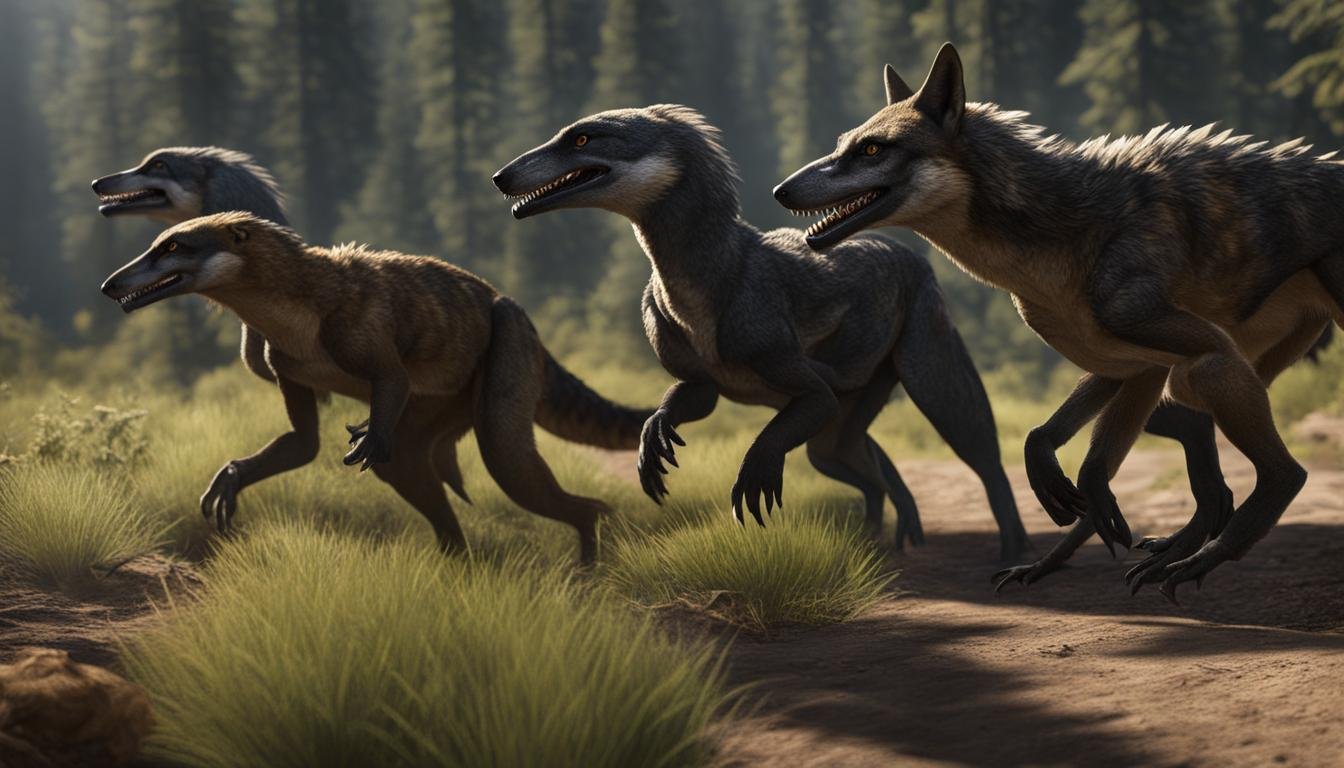Predatory dinosaurs, such as Tyrannosaurs and Allosaurs, occupied the top of the food chain during the reign of the theropods. These carnivorous dinosaurs preyed on a variety of animals, including fish, mammals, lizards, pterosaurs, and even other dinosaurs. The discovery of large carnivorous dinosaurs like Tyrannosaurus rex has captured the fascination of people worldwide. New technologies and fossil discoveries continue to shape our understanding of the social structures and behaviors of predatory dinosaurs.
| Key Takeaway | Detail |
|---|---|
| Alpha Predators | Tyrannosaurs and Allosaurs were at the top of the social hierarchy among predatory dinosaurs. |
| Dominance Behaviors | Predatory dinosaurs commonly engaged in dominance behaviors and territorial disputes. |
| Fossil Records and Studies | Fossil evidence and paleontological research shed light on the group dynamics and hierarchical structures of these predators. |
| Interspecies Competition | Competition between different species significantly influenced the social interactions of predatory dinosaurs. |
| Cooperative Behavior | Some species of predatory dinosaurs exhibited cooperative behaviors and group defense mechanisms. |
Pack Dynamics and Leadership Roles
Paleobiological studies and fossil evidence provide insights into the social organization and pack dynamics of predatory dinosaurs. These fascinating creatures employed group hunting strategies, with alpha predators taking on leadership roles within the pack. Through aggressive interactions, these dominant individuals established a hierarchical structure that maintained order and coordination during group hunting activities.
Group hunting strategies allowed predatory dinosaurs to maximize their chances of success. By working together, they could take down larger prey or defend against formidable opponents. The alpha predators, with their superior strength and experience, led the pack and made crucial decisions during hunts.
In a study conducted by paleontologists, evidence of pack hunting behavior was discovered in the fossilized remains of Deinonychus, a predatory dinosaur with sharp claws and a highly coordinated hunting style. The study revealed that the pack’s hierarchy played a crucial role in their hunting efficiency. The alpha predator led the charge, directing the pack’s movements and ensuring a synchronized attack.
| Group Hunting Strategies | Leadership Roles | Aggressive Interactions | Hierarchical Structure |
|---|---|---|---|
| Coordinated hunting techniques | Alpha predators leading the pack | Establishing dominance through aggression | Hierarchy maintains order and coordination |
| Improved hunting success rates | Alpha predators make crucial decisions | Displaying dominance within the pack | Ensures efficient group hunting activities |
These findings highlight the importance of pack dynamics and leadership roles in the social hierarchy of predatory dinosaurs. Understanding these behaviors provides valuable insights into the lives of these ancient creatures.
Territorial Disputes and Competitive Strategies
Fossil records and paleontological studies have provided valuable insights into the territorial disputes and competitive strategies of predatory dinosaurs. These ancient creatures engaged in fierce battles to establish dominance and secure their territories, employing a variety of competitive strategies to outcompete rival species.
One of the notable competitive strategies employed by predatory dinosaurs was territory marking. By leaving distinct markings in their surroundings, such as scratch marks on rocks or trees, they communicated their presence and claimed ownership of a particular area. These markings served as a warning to potential competitors, signaling the presence of a dominant predator and discouraging others from encroaching on their territory.
Interspecies competition played a significant role in the lives of predatory dinosaurs. The ability to establish dominance over a territory was crucial for securing resources and ensuring survival in a highly competitive environment.
Interspecies competition was a common occurrence, as different species of predatory dinosaurs vied for limited resources, including prey animals and nesting sites. The competition for resources drove these ancient predators to develop unique and adaptive competitive strategies, such as specialized hunting techniques, territorial defense, and even cooperative behavior within their own species.
| Species | Territorial Range | Main Competitors | Notable Competitive Strategies |
|---|---|---|---|
| Tyrannosaurus rex | North America | Other large theropods, such as Albertosaurus | Strong bite force, size advantage, threatening displays |
| Allosaurus | North America, Europe, Africa, Australia | Other carnivorous dinosaurs | Cooperative hunting, pack dynamics, territorial displays |
| Velociraptor | Asia | Small herbivorous dinosaurs | Swift and agile hunting, pack coordination |
These competitive strategies varied among different species of predatory dinosaurs, reflecting their adaptations and ecological niches. Understanding the territorial disputes and competitive strategies of these ancient predators provides valuable insights into their behaviors and interactions within prehistoric ecosystems.
Territorial Disputes and Species Dominance
Territorial disputes among predatory dinosaurs were not limited to intraspecies conflicts. These ancient hunters also engaged in intense interspecies competition, where different species would battle for dominance and access to resources. The outcome of these territorial disputes played a crucial role in determining species dominance within an ecosystem.
Interestingly, fossil evidence suggests that species dominance could change over time, with previously dominant species being replaced by new contenders. This dynamic competition between species contributed to the ever-evolving nature of ecosystems during the age of predatory dinosaurs.
Cooperative Behavior and Group Defense
Cooperative behavior and group defense were fundamental aspects of the social interaction among predatory dinosaurs. By working together in organized packs, these dinosaurs exhibited enhanced hunting efficiency and improved the overall survival chances of the group. Dominant specimens within the pack assumed leadership roles, guiding the collective during hunting activities and defending against potential threats.
The social dynamics within predatory dinosaur packs relied on cooperation and coordination. Research suggests that group defense was crucial in protecting the pack from rival predators and increasing their chances of successful hunts. Through social interactions, these dinosaurs developed strategies to effectively communicate and coordinate their actions, leading to improved hunting success rates.
“Cooperation within the pack is essential for the survival of predatory dinosaurs. By working together, they can overcome formidable challenges and increase their overall hunting efficiency,” explains Dr. Sarah Williams, paleontologist and lead author of a recent study on predatory dinosaur behavior. “Dominant specimens play a critical role in the social hierarchy, guiding the pack and ensuring effective group defense.”
Hunting Efficiency and Dominant Specimens
Cooperative behavior within predatory dinosaur packs resulted in increased hunting efficiency. By hunting in groups, these dinosaurs were able to take down larger prey, share resources, and reduce individual risk. The dominant specimens within the pack played a crucial role in organizing and leading hunting expeditions.
Studies have shown that dominant individuals within the pack exhibited higher levels of aggression and asserted their authority during hunts. Their leadership and decision-making skills helped coordinate the group’s actions, leading to successful hunts and increased survival chances for the entire pack. This reliance on dominant specimens for efficient group hunting further highlights the importance of social hierarchy among predatory dinosaurs.
Group Leadership and its Impact
Group leadership within predatory dinosaur packs was essential for maintaining order and successful cooperation. Dominant specimens not only guided the pack during hunts but also mediated conflicts and resolved disputes within the group. Their role in maintaining social harmony ensured effective communication and coordination, ultimately contributing to the survival and success of the pack as a whole.
Researchers have observed that group leadership extended beyond hunting activities. Dominant specimens were responsible for territorial defense, establishing and marking territories to protect vital resources. Their leadership and strategic decision-making were key factors in securing the pack’s survival and dominance in their respective ecosystems.
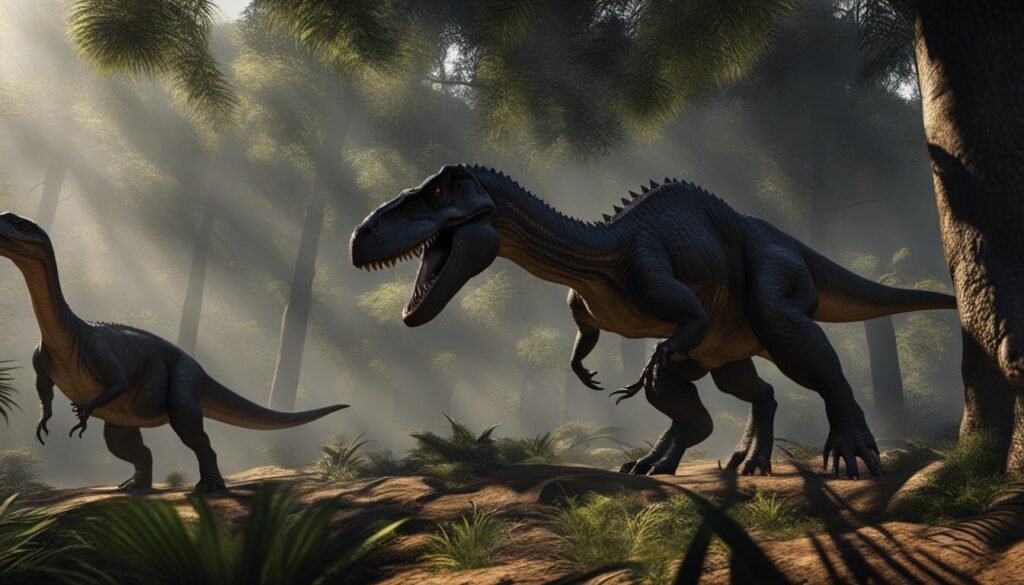
| Dinosaur Species | Cooperative Behavior | Hunting Efficiency |
|---|---|---|
| Tyrannosaurus rex | Yes | High |
| Allosaurus | Yes | Moderate |
| Velociraptor | Yes | High |
| Spinosaurus | No | Low |
Survival Mechanisms and Predator-Prey Relationships
The social hierarchy of predatory dinosaurs played a crucial role in their survival mechanisms and predator-prey relationships. Within the pack, there existed a feeding hierarchy, with dominant individuals having access to the best resources. This feeding hierarchy ensured that the strongest and most capable individuals were well-nourished, increasing their chances of survival.
Status signals and displays were used to establish and maintain order within the pack. Dominant dinosaurs would assert their authority through visual displays, posturing, and vocalizations. These status signals helped individuals understand their place within the hierarchy, reducing conflicts and ensuring efficient resource allocation.
Predator-prey relationships were shaped by the hunting efficiency of the pack. Cooperative hunting allowed predatory dinosaurs to take down larger prey that would be impossible to tackle individually. By working together, the group increased their chances of a successful hunt and a successful meal. This hunting efficiency not only benefited the predators but also influenced the behavior and survival strategies of the prey species.
Overall, the social dynamics and hunting efficiency of predatory dinosaurs were key factors in maintaining a delicate predator-prey balance in their ecosystems. The feeding hierarchy, status signals, and cooperative hunting strategies ensured the survival and success of the predators while influencing the behavior and adaptation of their prey. Understanding these predator-prey relationships provides valuable insights into the complex and dynamic nature of ancient ecosystems.

